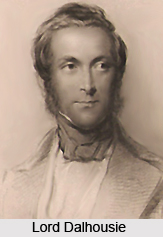 Lord Dalhousie carried out many reforms in various fields. They keynote of his reforms was centralisation. Dalhousie wanted to gather all the threads of his power into his own hands. He organised the non-Regulation System to meet the new needs of the Indian Empire. Under this system, the administration was to be carried on by a Commissioner who was to be responsible directly to the Governor-General-in-Council. Its chief merit was the economy of the personnel. It did not make any distinction between civil and military matters. The District Magistrate was given all the powers in various fields.
Lord Dalhousie carried out many reforms in various fields. They keynote of his reforms was centralisation. Dalhousie wanted to gather all the threads of his power into his own hands. He organised the non-Regulation System to meet the new needs of the Indian Empire. Under this system, the administration was to be carried on by a Commissioner who was to be responsible directly to the Governor-General-in-Council. Its chief merit was the economy of the personnel. It did not make any distinction between civil and military matters. The District Magistrate was given all the powers in various fields.
Railways and Telegraph got an impetus from Dalhousie. Their development was considered necessary from the point of view of the defence of the Indian Empire and also for encouraging British investments in India. He entered into contacts with English Corporations for the construction of Railways. All kinds of facilities were given to them for work. They were guaranteed interest by the government irrespective of their profits. A few strategic railway lines were constructed at enormous cost to the Indian revenues but it helped the English capitalists to make huge profits. Telegraph wire linked up the various parts of India and this fact helped the English a great deal during the revolt of 1857.
Lord Dalhousie followed a policy of free trade to help of British traders and manufacturers. All ports of India were declared free. Improvements were made in lighthouses and harbours. All hindrances in the way of the flow of goods and capital were removed. All the coastal trade of India fell into the hands of English capitalists and that in fact led to the economic exploitation of the country.
A separate Public Works Department was set up in every Presidency and its important officers were the Chief Engineers and the Executive Officers. They were all imported from England. The reorganised Departments of Public Department of Public Works took up the task of constructing roads, canals and bridges.
Certain changes came about in the field of education as well. Universities were to be set up in India in the model of the University of London. There was to be a Director-General of Education for the whole of India. Education was to be entirely secular. Universities were established in 1857 in Bombay, Calcutta and Madras.



















